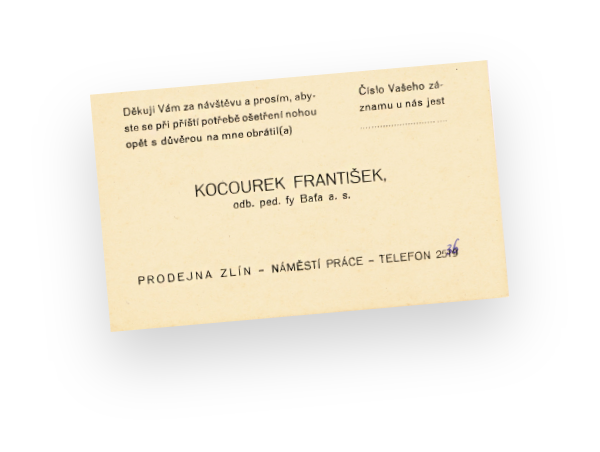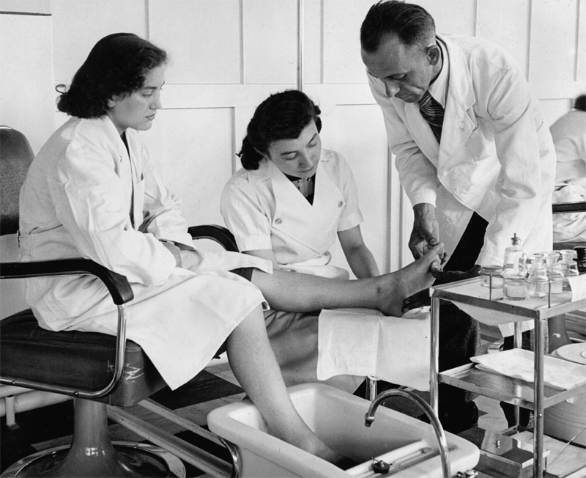
scroll


František began his studies at the Kyjov High School. When it was closed he moved to Prague to live with his brother and, upon graduating in 1917, joined the army. He received military training in Vienna and served on the Romanian front and in Galicia. At the end of the war, František enrolled as a medical student at a university in Prague but, when the Masaryk University was established in Brno, transferred to its Faculty of Medicine to continue his studies in his native Moravia. Although he earned the degree of MUC (Candidate of General Medicine), he was unable to complete the full medical curriculum due to the horrible war memories evoked by the sight of blood.




Chiropody Instructor, and gave him the task of spearheading Bata's entry into the business of foot care. Kocourek thus became Bata's first Chiropodist and, over the years, attracted a long list of famous clients. As Baťa's Chiropody Instructor, Mr. Kocourek was responsible for training foot care specialists in Czechoslovakia and overseas, and for preparing instruction manuals.
His postings abroad included Yugoslavia and France, where he spent four months based at the factory in Hellocourt. Following the Nazi occupation of Bata's factories in Czechoslovakia, Kocourek was so valued by his new employers that he was transferred to a clinic in Berlin where he met, among others, Reinhard Heydrich, Joseph Goebbels and Eva Braun.
As a Bata man and a great admirer of T. G. Masaryk, he abhorred the communist takeover of Czechoslovakia in 1948 but continued to teach courses in Chiropody, including at the Apprentice School of Commerce in Koryčany. He captured his long experience in a textbook, The Theory and Practice of Foot Care. He died in 1986.
















Following the massage, wipe the skin thoroughly to remove any cream. Pour a small amount of Frankovka* into the palm of your hand and rub it quickly over the leg and shin so that it penetrates the pores of the skin. This produces a cooling and refreshing sensation and promotes blood circulation in the capillaries. There is no point in trying to rub the Frankovka into the skin without removing the cream. It is a waste of the product and of no benefit to the person receiving the massage. * An alcohol-based solution containing, herbs essential oils and menthol.
Please note that if the customer has particularly hairy shins, great care must be taken to use ample cream during the massage. Otherwise they will have the sensation that the hair is being pulled, and you risk actually pulling some of it out.
The same care should be taken if customers have dry, broken or soft skin (which is particularly common in big cities). In such cases the massage must be performed gently and carefully so as not to damage the skin as this might allow bacteria to enter and cause undesirable complications.
Meticulous cleanliness, both of the feet of the person receiving the massage and of the hands of the pedicurist, is the only means of avoiding the small but unpleasant sores which can result from the cream. Cream that is not protected from dust may become harmful. Practitioners must keep this constantly in mind and never leave the cream container opened when it is not in use.
In order to avoid the customers' clothes being stained by the cream, it is advisable to place a clean towel under the edge of the clothes and have the customer hold it in place. We emphasize again that talcum powder should not be applied on the shins as this is not where sweating occurs. The talcum looks repulsive and may offend the customer. It should not be used without good cause. The visitor must be left with the impression that he/she has been served in a truly professional manner.
A perfectly clean towel must be provided for each customer. It is inadmissible to use the same towel for more than one visitor. It would be a grave offence against the basic requirements of cleanliness in pedicure work. Again, we stress that it is absolutely unacceptable for the pedicurist to wear rings when treating and massaging the feet. Even a wedding ring must be removed as it is not sterile, even if the chances of its causing scratches are minimal.
MUC. F. Kocourek, Theorie a praxe pedikury, 1954